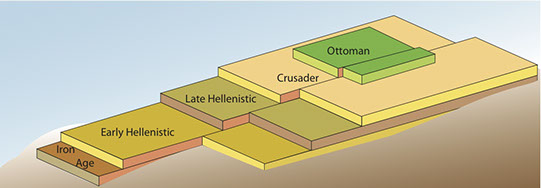The archaeological Tell of Ateret (North Israel), constructed on the active Dead Sea Fault between the tectonic plates of Arabia and Sinai, was intermittently settled for over six millennia. A series of structures that were built in the Tell has been offset by earthquake ruptures on the DSF, provide a remarkable record of alternating construction and slip.
Excavations of Ateret are led by Ronnie Ellenblum (Hebrew University). Amotz Agnon (Hebrew U) and myself as well as other geologists and archaeologists have been collaborating with Ronnie since 1994. Main partners include Tom Rockwell, Rivka Kalderon, Kate Raphael, Robert Kool, Roi Porat, Uri Davidovitch, and Micky Golan the excavation administrator.
Publications related to Ateret
- Ellenblum, R., Marco, S., Agnon, A., Rockwell, T., and Boas, A., 1998, Crusader castle torn apart by earthquake at dawn, 20 May 1202: Geology, v. 26, no. 4, p. 303-306. pdf
- Marco, S., Agnon, A., Ellenblum, R., Eidelman, A., Basson, U., and Boas, A., 1997, 817-year-old walls offset sinistrally 2.1 m by the Dead Sea Transform, Israel: Journal of Geodynamics, v. 24, no. 1-4, p. 11-20. pdf
- Segal, Y., Marco, S., and Ellenblum, R., 2003, Intensity and direction of the geomagnetic field in 24 August, 1179 measured in Vadum Iacob (Ateret) Crusader Fortress, northern Israel: Isr. J. Earth Sci., v. 52, no. 3-4, p. 203-208. pdf
- Ronnie Ellenblum, Shmuel Marco, Robert Kool, Uri Davidovitch, Roi Porat, Amotz Agnon, 2015, Archaeological record of earthquake ruptures in Tell Ateret, the Dead Sea Fault. Tectonics, 34, doi:10.1002/2014TC003815. pdf

.jpg?crc=3822794833)





























31 - 31
<
>


